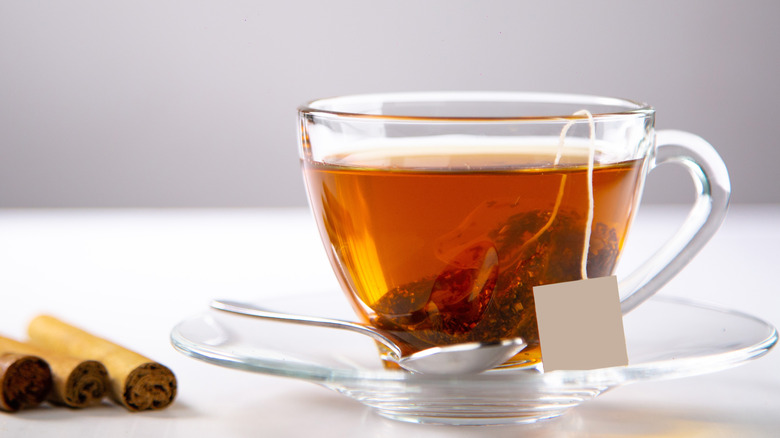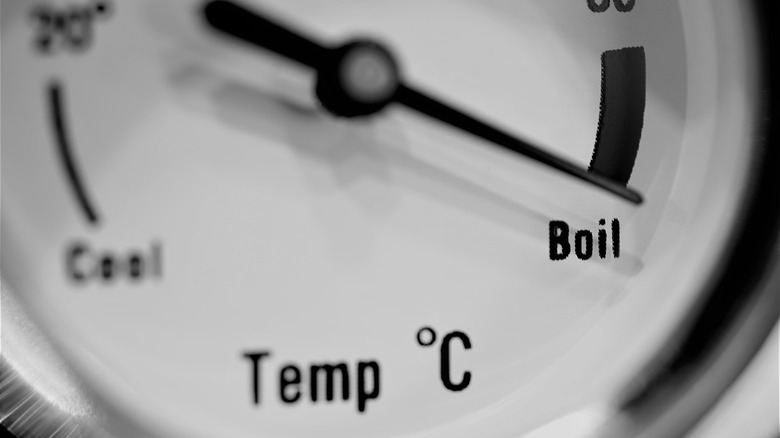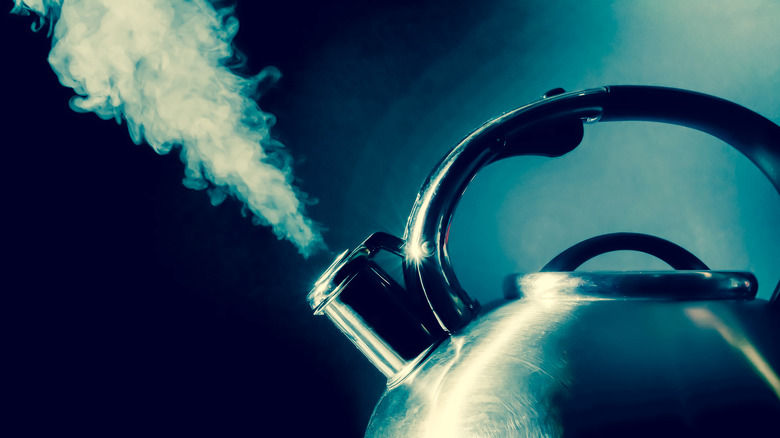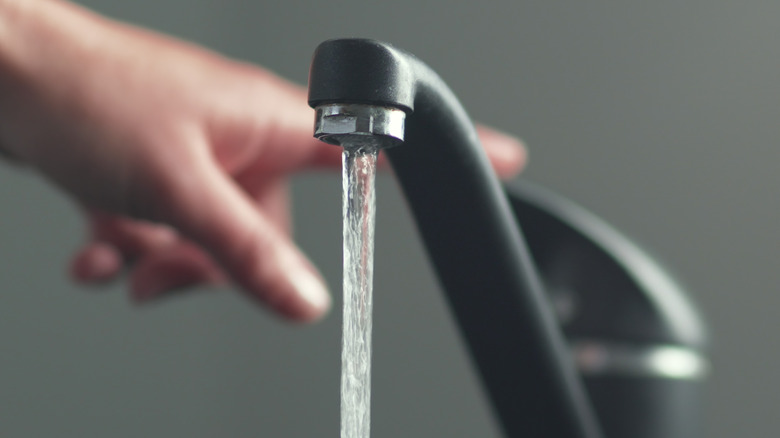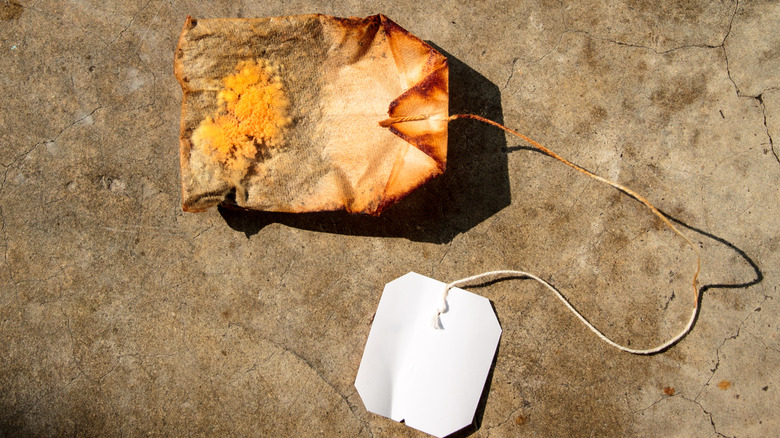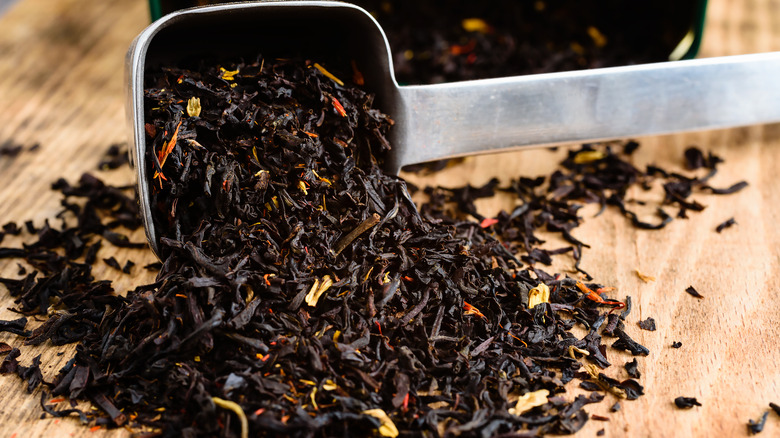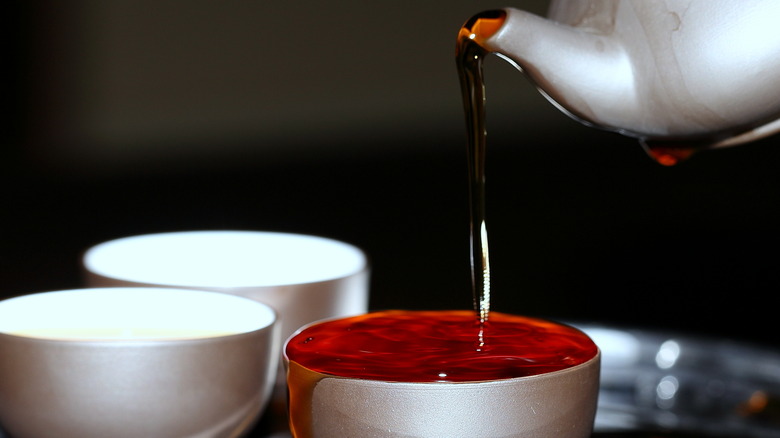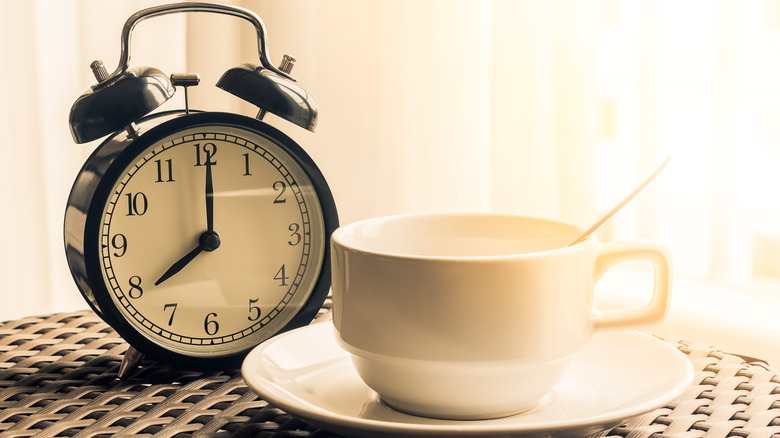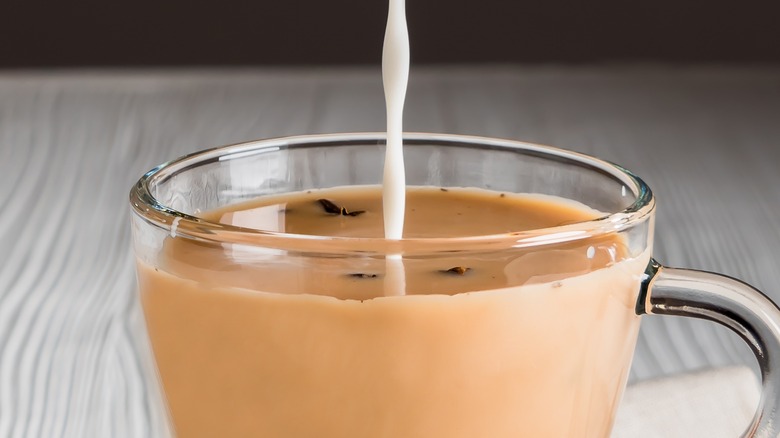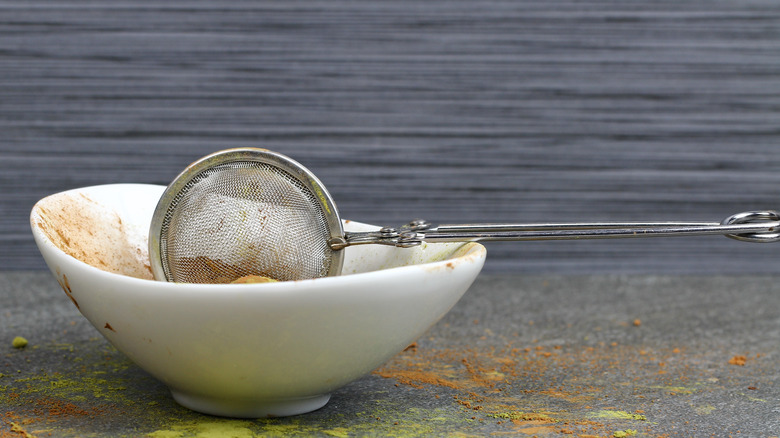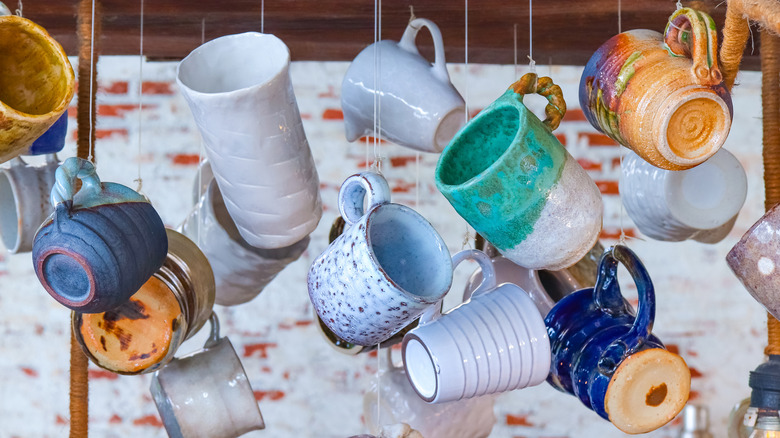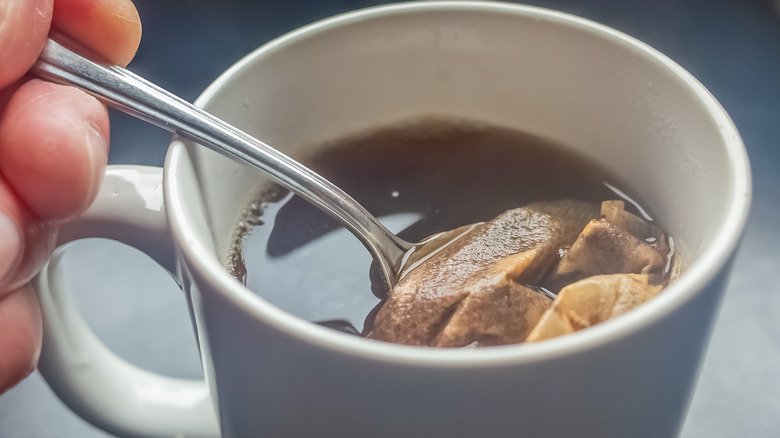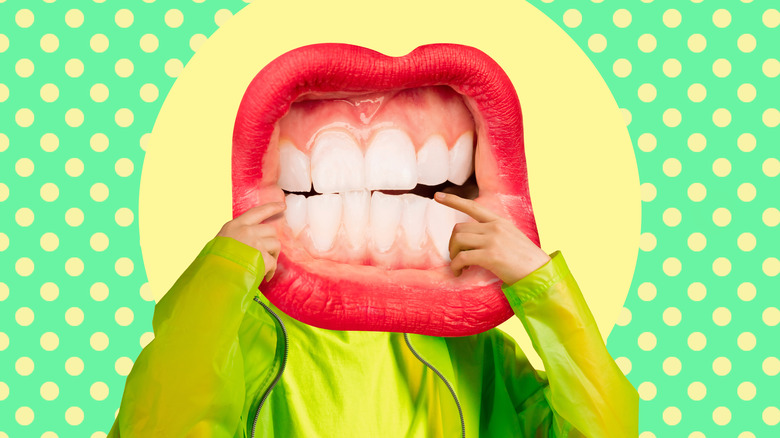Mistakes Everyone Makes When Brewing Tea
There are few things more surprising than sitting down to enjoy a nice cup of tea, taking a sip, and getting a mouthful of bitter, acrid liquid. What happened and what went wrong? And why does this keep happening?
The answer is attention. You haven't been paying attention, and that's totally fine. Perhaps you just didn't know that all teas are not created equal — you can't brew green tea at the same temperature (or time) as peppermint because, for one, peppermint tea isn't an actual tea. It's a tisane (via Dynasty of Tea).
Just think of consistently steeping tea incorrectly like a lesson you're supposed to learn (or relearn). Just like the movie Groundhog Day — you'll finally learn whatever lesson you're supposed to learn and then be able to move on with your life (wink, wink). Lucky for you, learning to brew tea properly can be narrowed down to a few common mistakes, which you'll find below. If you're serious about tea (and are tired of steeping an underwhelming or excruciatingly disgusting cup), keep on reading for mistakes everyone makes when brewing tea (and how to, you know, not do that anymore).
Your water temperature isn't right
When preparing tea, it seems relatively simple to make a cup (or pot) of tea. You get out your loose-leaf or prepackaged teabag, add boiling water, and let your tea sit for whatever duration of time seems appropriate. Then, it's perfect and ready to go, right? It's actually a little more complex than that.
While the boil n' pour method seems like it would work, different types of teas call for different brewing temperatures (via Artful Tea). As a general rule of thumb, water temperature should float somewhere between 60 degrees Celsius (140 degrees Fahrenheit) for your more delicate teas (like white or green teas) and a full rolling boil (100 degrees Celsius or 212 degrees Fahrenheit) for potent black and herbal teas (like Rooibos, chamomile, and Darjeeling).
The reason, writes Rishi Tea, is "because the wrong water temperature can cause an over-extraction or under extraction of polyphenols (tannins), which can alter the flavor of your tea." In other words, your tea can end up tasting super bitter or tasting like nothing at all. To prevent over or under extracting, it might be wise to invest in a food-grade thermometer, just in case. The last thing you'd want to do is ruin that special $40.00 per ounce tea your friend just brought back from Europe.
Lastly, don't use a microwave. There's no way you can guess what the temperature is going to be.
You're boiling your tea to death
When it comes to teas that require boiling water, there are a few guidelines to follow. First, boil that water. Boil it until it reaches a nice, full roll, and then remove it from heat. Second, practice the pause — don't pour boiling water onto that poor, unsuspecting little satchel. This is one of the most common mistakes when making tea, according to Better Homes & Gardens. Tea drinkers see "add boiling water" and just douse that tea packet until it's fizzling on the surface of the water.
If the instructions on the back of your tea packet (or box) say use boiling water, don't go pouring boiling water directly on that poor little flavor satchel. Just wait a few minutes for the water to cool down a bit, as recommended by RishiTea.
But does it really matter that much? Yes, yes it does. Aside from possibly scorching the delicate tea leaves and burning the flavor right out of them, overly hot water also overextracts the leaves, releasing bitterness that might not otherwise be there (via RishiTea). You can't fix a cup of tea that's been ruined. The only thing it can be used for is watering plants. When your tea kettle starts screaming or your electric kettle clicks off, practice the pause and wait before giving your tea a proper bath.
You're using not-so-great water
It's not that your water is undrinkable and absolutely disgusting, but according to Fresh Cup Magazine, the pH level, total dissolved solids (that sounds questionable, doesn't it?), and water hardness all play a major role in the way your tea tastes (just like the process for brewing a nice cuppa coffee). So, how do you know if your super tasty, 100% locally sourced municipal water is tea-quality? First off, if you already know your water is highly chlorinated, the Tea Association of the USA recommends boiling it to remove these impurities.
Tap water pH isn't something people in the states need to worry really about (Healthline reports it as 7.5, which is neutral). Total dissolved solids (TDS) refers to the number of minerals, metals, salts, and other things that are in the water. Hardness measures magnesium and calcium levels. If you've ever seen white flaky stuff appear around the mouth of your kitchen faucet, congratulations. That means you have hard water. Soft water is great for drinking ... but forget about showering in it, you'll never feel like you got the soap off. If you're unsure about your water quality, the New York Times recommends the SimpleWater Tap Score Water test. The Environmental Protection Agency has a whole slew of references on its water quality resource page.
Your tea is old
If your tea has an expiration date, DoesItGoBad.com says that it's still safe to consume past the given date (as long as it has been stored properly). TeaCrossing explains that, essentially, expired tea means there are no more natural oils present in the tea leaves, and any cup brewed with those tea leaves will probably be dull, lifeless, and watery. Artful Tea claims that even if the tea in question is past its prime, if it has been stored properly, the tea is most likely safe for consumption.
The best way to tell if tea has expired or gone "bad" is to smell it, and if it's still aromatic, then go forth and brew on. However, keep in mind that tea is an herb (plant), so no matter what, it will eventually begin to degrade and lose its potency over time. Lets Drink Tea mentions that your tea should be mold-free without any dank or pungent essence (unless that's what it's supposed to smell like, which might make things difficult). If your tea is free from mold and doesn't smell pungent or dank, you're doing good so far. If the tea in question has no smell at all, Brewed Leaf Love says that dried tea leaves make great fertilizer, and that's a much better option than a bland cup of tasteless tea.
Storage could be a factor
Tea may just be dried-up fermented foliage, but it can get old. Tufts says that to ensure your tea stays as fresh as possible (for as long as possible), transfer your loose-leaf (or prebagged) teas into an airtight container as soon as you can. Store that airtight container away from kitchen appliances — your sink, stove, fridge, dishwasher, microwave — and out of direct sunlight. If you haven't figured it out, the best place for your airtight tea storage capsule is in your pantry, cabinets, or kitchen counter (via Tea Crossing).
Improperly stored tea will begin to lose its potency and has the potential to go bad if exposed to any of the four natural elements. What's meant by potency? Well, the aroma for one. Second is flavor. Element-proof tea containers do best with a double-sealed lid or using a canister with a silicone seal. This keeps the freshness in and the nasty stuff out.
There's such a thing as too much or too little
If your tea is tasting less than stellar, it's time to reevaluate how much tea (and water) you're actually using. For obvious reasons, if your ratios are off, your tea is either going to be way too strong or taste like you're milking that tea bag for all its worth.
A general rule of thumb is that you should use one teaspoon of loose-leaf per six ounces of water (via Artful Tea). But this generic rule can vary depending on the type of tea you're using, whether it's loose-leaf or bagged, and the size of the mug. Prebagged teas usually have brewing instructions on them, so you should follow those instructions. For example, TwiningsUSA says that you should use one tea bag per cup (meaning six ounces) of water, while one to two teaspoons of loose-leaf should be brewed with eight ounces of water.
What it comes down to is basic math. Let's say you have a 12-ounce cup. If one tea bag is brewed with six ounces of water, then you would use...two teabags, right? If you were using loose-leaf, then two teaspoons should do the trick. Remember that measuring out the water-to-tea ratio isn't rocket science. If you don't have a measuring spoon, then use a normal spoon.
Your timing is off
Just like the tea to water ratios, time is an incredibly important aspect for properly steeping a delightfully satisfying cup. Have you ever let your tea sit too long, or were in a rush and pulled the sachet out too early? The result was pretty gross, right? Too bitter or completely devoid of flavor, or perhaps you let your green tea steep for more than five minutes.
Different teas call for different steep times. If you steep almost any tea for too long (this is a bit different for herbal teas), the natural tannins — present in all teas — are released, resulting in a super bitter brew. The more delicate the tea — green, white, and oolong — the less steep time they require. Why? It all comes down to the way the tea has been processed (via Upton Tea Imports). Black tea has a completely different "cooking" process than green tea. Black teas are withered, rolled, allowed to ferment (oxidize), and then dried. While green tea is also withered, it is pan-fried or steamed and then dried. These processes release chemicals that give these teas their signature color, flavor, and smell. The steep time makes for the optimal release of all the good antioxidants and polyphenols. If you don't steep it long enough, you don't reap the full benefits. On the flip side, you're not going to gain extra health points if you steep your brew more than the recommended allotment (via Well+Good).
Dairy might be the culprit
If you're a tea (or coffee) drinker who feels obligated to put a cream-based liquid in all of your hot or cold drinks, it's time to reconsider your dilution choices. The truth is, not all teas need — or should even contain — milk or creamer. Teas that are stronger and have a longer oxidation period (the time that tea leaves are exposed to air to dry, darken, and become more flavorful, as explained by Artful Tea) can hold up much better to cream or milk-based additives. These teas are usually black teas — Darjeeling, Assam, Ceylon, and Keemun — and black tea blends — Breakfast Blend or Irish Breakfast.
Teas that don't really need their creamy counterparts are the more delicate flavored brews, like green, Oolong, white, and yellow teas (via TeaSource).
That being said, it's not tea taboo if you enjoy putting half-and-half in your jasmine green. Everyone has their own personal preference. In fact, drinking milk (with tea) has been traced back to Mongolia circa the 13th and 14th centuries (via JamoGrand.com). While drinking tea and adding milk wasn't necessarily commonplace among the Mongols, consuming milk and adding in flavors like tea leaves, ghee, millet, and salt (a beverage called Suutei tsai) was more common. These were primarily milk-based drinks that are now referred to as "milk teas" (via Sunbasket).
There could be residuals on your teaware
If you use a strainer to brew your tea, make sure that it's been cleaned properly. There are some types of strainers that will hold onto aromatics and essential oils from each tea steeping. Even if you're using a steel or metal mesh strainer, these need to be cleaned thoroughly to prevent any possible flavor contamination (via TeaSteeping.com).
According to The Tea Box, different wares call for different cleaning methods. Good Housekeeping notes that most (if not all) DIY cleaners contain at least one of the following: Baking soda, vinegar, or lemon juice, in addition to water. The same cleaning methodology should be applied to your tea vessel (also known as your mug). Make sure it's free from chips or cracks (because no cleaner, natural or chemical, can remove stains from porous materials). If you find "blemishes," then it's time to thank your cup for doing such a great job, and then remove it from your kitchen. That fractured cup shouldn't be anywhere near your mouth.
As finicky as it sounds, you should try your best to avoid cross-contamination — items for coffee should remain for coffee, for example. The same goes for tea, and the same for your soup cup.
You're using the wrong teaware
As previously mentioned, if you're using the same mug that you drink coffee in (or eat ramen out of) then it's time to invest in some new teaware specifically dedicated to tea. You know how some foods taste better when you eat them out of certain dishware? The same goes for tea.
The Tea Box points out that glass works well for tea because you get to watch the tea itself infuse into the water (almost like a little tea lava lamp). The downside is that some glass isn't heat-resistant, can possibly break, or get so hot that you can't handle it. Ceramic holds heat well (via GreyFoxPottery), which is why many mugs are made out of it. However, the lighter colors have a tendency to stain, so take that into consideration. The Tea Box also mentions porcelain and stainless steel as suitable options because porcelain doesn't absorb odors, and metal is a good conductor of heat . What it comes down to is personal preference. As long as you're not using the same mug for everything, then its all up to you.
You're squeezing your teabag
Pressing your teabag to remove the remaining water isn't just a funny quirk among tea-snobs, though some consider it to be poor (not pour) tea etiquette. The reason — besides running the risk of rupturing this fragile bag of dried leaves — is that squeezing the remaining life out of it can release a bitter compound called tannic acid (via Premium Steap).
Healthline states that tannins (or tannic acid) are naturally occurring compounds found in all tea leaves. Through oxidation, these tannins become more prominent in the form of bitterness. You can really taste tannic acid in black teas (which have a longer oxidation time). If you squeeze that bag, you're ultimately releasing a super bitter flavor profile into your otherwise perfect cuppa, and unfortunately, what's been done cannot really be undone (though dairy can somewhat mellow it). In addition to a nasty flavor and potentially chewy tea, Colgate reports that the tannins released from your tea can stain your teeth, possibly even more than coffee.
Your mouth is off
MedlinePlus says that we have approximately 10,000 taste buds that allow us to identify the five basic tastes: sweet, salty, sour, bitter, and umami. Like a phoenix rising from the ashes, our taste buds regenerate (die and grow back) every two weeks or so (via ClassPass). As you can see from the childhood versus adulthood taste preference test, your tastes change. MedlinePlus says that around age 40, your taste buds begin to regenerate a little slower. Besides aging, there are other contributing factors to why your taste buds might be malfunctioning, including certain medications, injuries (like burns or bites), illnesses (like cancer), and smoking (via Healthline).
If you think back to when you were a kid, there are probably a few foods you hated, but that you are privy to now. You know, things like coffee, dark chocolate, aggressive cheese (as in you only ate American and string cheese), or avocados (via Easy Family Recipes). Ultimately, what you might like one day, you might hate the next because your body is ever-changing (and that includes your taste). Enjoy your peppermint tea while you can because you never know, you might hate it tomorrow.
